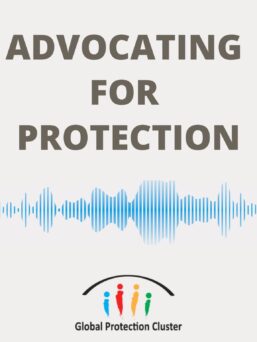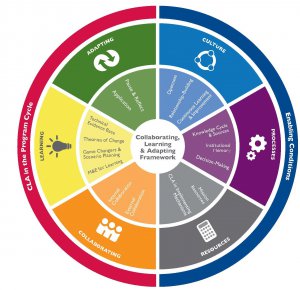Understanding Global Protection Advocacy through Results-Based: A Reflection on The Global Protection Cluster’s Podcast on Advocating for Protection
Results-Based Protection and Global Protection Advocacy
In a world where global protection advocacy is shrinking and the disconnect between humanitarian operations, protection advocacy and protection work is increasing, a results-based approach to protection may prove as an extensible tool that can help revitalize these working parts.
Historically, protection advocacy has sprouted organically out of local needs that are defined and conveyed by local organizations. These locally-driven efforts form coalitions composed of actors from the humanitarian INGOs, UN agencies, diplomatic missions, national institutions, and civil society. Such coalitions reflect the need for multiple actors in achieving common protection advocacy outcomes. Additionally, although INGOs and humanitarian agencies adopt differing advocacy modes of action ranging from denunciation to support in response to violence against civilian populations, these stands of advocacy should be defined by the context-specific and ever-evolving perspectives of affected populations. The central goal of protection advocacy should be to support protection outcomes defined and prioritized by communities affected by crises. The three key elements of RBP strongly reflect components of global protection advocacy, underpinned by the need to understand the functions of institutional and civilian populations’ cultures, resource distribution and the role of systems in advancing, or disadvantaging, successful advocacy.
Connecting to the podcast
In this podcast, Gemma Davis, from the ODI Humanitarian Policy Group, elaborates on how empowering civilians from civil society organizations and including their perspective in global level protection advocacy decision-making spaces will help bridge the wide gaps between policy discourses and the lived field realities for humanitarians working on reducing protection risks.
This conversation, hosted by the Global Protection Cluster, unveils the narratives of those who stand up for the most vulnerable in times of crisis. Co-led by Oxfam and Save the Children, the Advocacy for Protection Group at the Global Protection Cluster brings forth a rich dialogue that discusses the dwindling trajectory of global protection advocacy in the wake of the 21st century. The dialogue centers around how the current structural setbacks rooted in popular norms in the humanitarian aid sector can be overcome by new transformative and strategic reinvestment in humanitarian protection advocacy which focuses on the positionalities and desired outcomes of populations living in crisis.
Speaker Spotlight: Gemma Davis
One of the key voices in this space is Gemma Davis, whose journey began at Médecins Sans Frontières (MSF). Here, she was immersed in a unique culture known as “temoignage,” rooted in the French verb “temoigner,” meaning “to witness.” This culture emphasizes gathering evidence from the populations MSF serves and advocating on their behalf. Gemma Davis’s current work includes an ODI project aimed at strengthening protection advocacy. By amplifying the voices of affected populations and viewing them as fundamental for evidence collection that defines advocacy strategies and efforts, Davis reflects the need for context-specific and continuous protection analysis in producing quality protection programming that is in touch with the lived experiences of populations. Additionally, Davis authored a report titled “Complementary Approaches between International and Local Protection Advocacy: Don’t Speak for Me, I will speak for myself.” This report highlights how advocacy efforts often involve coalitions of international non-governmental organizations (INGOs), civil society, and international governing institutions. It reflects the evolution of protection advocacy methods, driven by dynamic geopolitical contexts and how a reinvestment in advocacy coordination that emphasizes collaboration rather than merely operational coordination between INGOs and their partners can reinvigorate protection advocacy. From a results-based protection perspective, effective advocacy coordination would mean identifying relevant entry points for each stakeholder involved in the advocacy initiative to achieve protection outcomes.
The changing landscape of advocacy and Results-Based Protection through a macro lens
The shift towards advocacy as a central component of protection work can be traced back to the genocides witnessed at the end of the 20th century and the beginning of the 21st century, such as those in Rwanda, Sri Lanka, and Darfur. However, over time, advocacy efforts have dwindled, marking a cultural shift in the humanitarian sector. There has been a notable increase in investment in coordination efforts, often diverting resources from advocacy. A pivotal question emerges: Should the international humanitarian community speak on behalf of civilians in conflict or provide them with a platform to speak for themselves? This dilemma becomes more complex when advocates share common values but divergent interests.
Striking the right balance between global advocacy and local empowerment is essential. Despite the absence of formalized advocacy tools and mechanisms at an institutional level, a glimmer of hope emerges. For example, local civil society organizations (CSOs), international humanitarian actors, and diplomatic entities have historically come together to raise awareness about alarming levels of gender-based violence (GBV) and accountability issues in South Sudan. This collaborative effort underscores the power of united voices advocating for protection. As highlighted by Davis in the podcast, even when the funding agencies and institutions do not define avenues for strategic advocacy collaboration, these efforts often happen organically on a grassroots basis. Inherently, advocacy centers the issues of populations affected by violence through amplifying their voices. In this light, integrating affected communities continuous and context-specific insights into advocacy talking points is instrumental to achieving tangible advocacy outcomes.
Ways forward in an RBP focused protection strategy
The Advocacy for Protection Podcast and the work of dedicated individuals like Gemma Davis remind us that protection advocacy, if undertaken through an outcome-oriented and results-based approach can be a transformative force in shaping humanitarian action that reflects the needs and priorities of populations in war zones, climate catastrophes and other humanitarian emergencies. It is a beacon of hope for those caught in the crossfire of conflicts, offering them a platform to speak for themselves, and paint an accurate picture of their lived struggles, hopes and goals. As the landscape of protection advocacy evolves, so must our strategies and approaches. The key enablers of achieving results-based protection outcomes provide a foundation to revitalize engagement between national protection actors, protection advocates, and humanitarians and jointly advancing advocacy at all levels.
The central question remains: How can the international humanitarian community effectively convene advocates with shared values but differing interests? In the pursuit of results-based protection, we must continue to seek answers to this critical question, ensuring that the voices of the most vulnerable are not marginalized by competing interests but empowered at every level.
The RBP team encourages you to tune into this dialogue on global protection advocacy.


